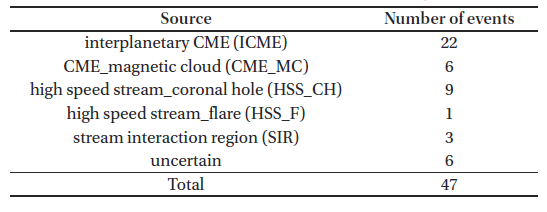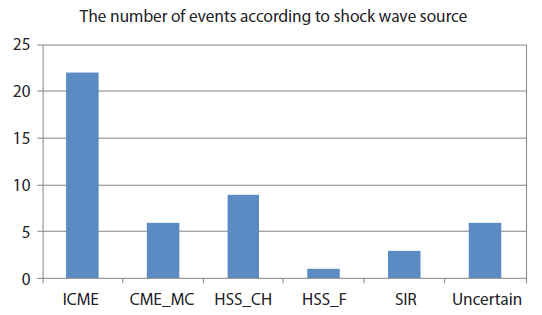1. INTRODUCTION
Solar activities have an effect on many satellites, the Earth’s magnetosphere and even ground-based systems. One of these, solar wind is mainly composed of protons and electrons and the sun releases particles about 100 million tons per second in the form of the plasma using solar wind. The solar wind is divided into two components, respectively the slow solar wind and the fast solar wind. Both of fast and slow solar wind are influenced by interplanetary coronal mass ejection (ICME) that is large, rapid plasma explosion. ICME is caused by erupting the sun’s magnetic field as a interplanetary version of CME. This induces a shock wave within the heliosphere and accelerate particles. When ICME impact with the Earth’s magnetosphere, it has an effect on the magnetosphere in a moment and induces a ring current and generates a geomagnetic storm. Also, ICME generates magnetic reconnection at magnetotail and then aurora is formed by protons and electrons moving down to Earth’s atmosphere. Also, one of the characteristic of solar wind is co-rotating interaction region (CIR). When materials are exploded with strong magnetic field from the sun, it is observed in the solar wind. A magnetic cloud is a region of enhanced magnetic field strength, smooth rotation of the magnetic field vector and low plasma temperature. CIR is a region where interact between fast and slow streams and is formed within the solar wind in interplanetary space. The fast solar wind in coronal hole catches up the slow solar wind and collide with it. So this interaction generates a shock wave and accelerates particles.
Blast wave is a phenomenon which explodes huge amount of energy stored in confined volume and is observed in planetary nebula and supernova remnant. Blast wave is a area of pressure expanding outward supersonically from a center of explosion and it makes a shock wave in front of compressed gases. Like light speed and sound speed, if the blast wave encounters the boundary of any material, it is partially transmitted, absorbed and reflected. Therefore, if a sudden explosion occur, physical quantities tend to decrease exponentially within a short time.
Ohki (2003) found out that high ratio of electron-proton observed in large-scale impulsive gamma-ray line (GRL) could be explained by depletion of proton rather than richness of electron. In this research, the definition of impulsive events was large-scale event related with flare event having huge amount of energy like GRL emission and meter-wave emission. He mentioned two possibility of high E/P ratio. One is the feature of accelerated particles in flare and another is difference of shock wave features between shock wave in corona and IP shock caused by CME. He selected the most strong 12 electron events to reanalyze the results obtained in Evenson’s research. Because the richness of electrons in relativistic electrons (5-11 MeV) shows the most prominent features in GRL flare explained in this research.
To carry out our research, we hypothesize a few things. we think that density depletion occur when the particles are pushed by shock wave or solar wind dynamic pressure in interplanetary space. If shock wave or dynamic pressure is strong, the scale of density depletion is small. The solar wind accompanied with shock wave will reach the Earth’s magnetosphere and if the intensity is weak, magnetosphere will inflate. In order to prove the hypothesis, we conduct this research using satellite data and statistics analysis.
2. DATA AND METHODS
To analyze the depletion events, we used advanced compos-ition explorer (ACE) and Wind satellite data. ACE satellite was launched in 1997 and is currently operating in L1 Lagrange point which lies between the Sun and the Earth at a distance of 1.5 million km. ACE satellite is equipped with 10 instruments and we used solar wind electron, proton and alpha monitor (SWEPAM) and magnetometer (MAG) data to know the parameters of solar wind and shock wave such as speed, density and the intensity of IMF. global geospace science (GGS) Wind satellite is a NASA science spacecraft launched at 1994. Major mission is to investigate the basic plasma processes within solar wind near the Earth and provides the plasma, energetic particles, magnetic field data necessary to the research of magnetosphere and ionosphere. Likewise ACE satellite, we used solar wind experiment (SWE) and magnetic field instrument (MFI) data. So we used the ACE data from 1998 to 2998 to analyze the density depletion by solar wind in interplanetary space. Because the observation of ACE satellite cannot be performed properly, we used the Wind satellite date in 1997 and from 2009 to 2013.
King & Papitashvili (2005) analyzed the comparison of hourly plasma and magnetic field data with two satellites and solar wind spatial scale. The research purpose is to compare hourly plasma and magnetic field data with two satellites and to quantify the systematic difference and random difference for hourly resolution. Fig. 1 is the scatterplot for solar wind parameters between ACE and Wind. Because we can know the high correlation coefficient between two satellites data in Fig. 1, we can use two satellites data.
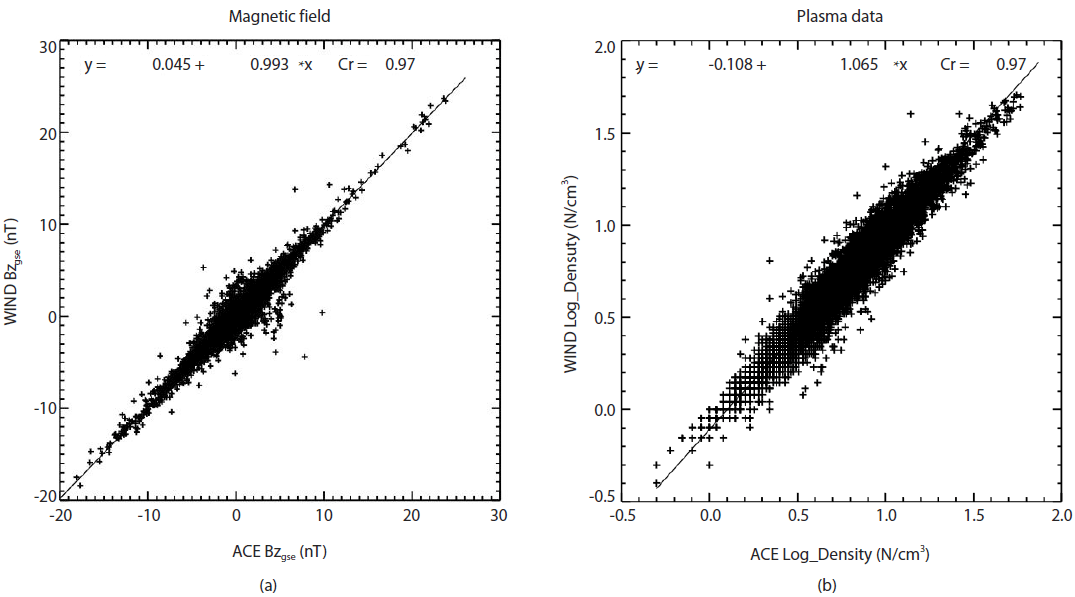
In this study, we defined the solar wind density depletion that solar wind density, specifically proton density, suddenly decrease and keep the state. It was known that solar wind density depletion occur after IP shock pass through the inter-planetary space like Fig. 2(a), but density depletion is generated by other source or independently like Fig. 2(b). we selected the criteria of this phenomenon that duration of depletion is 12 hr or more and average proton density is less than 1.5 particles/cm3. To find a relation between two data, obtaining the degree of correlation whether the correlation exist between two data is correlation analysis. We can know the correlation existing between variance using correlation analysis and correlation can be expressed as a probability function. The correlation degree is shown linearly. If the correlation between parameters is distributed linearly, coefficient comes close to If the correlation is different totally, it seems to spread in a circular form. There is a correlation between two parameters of positive or negative and linear relation may not exist.
The Eq. (1) is Pearson correlation coefficient that is one of the method measuring the degree of correlation statistically. We can explain simply
and this shows how two parameters interact with each other. Pearson correlation coefficient is defined as below Eq. (2).
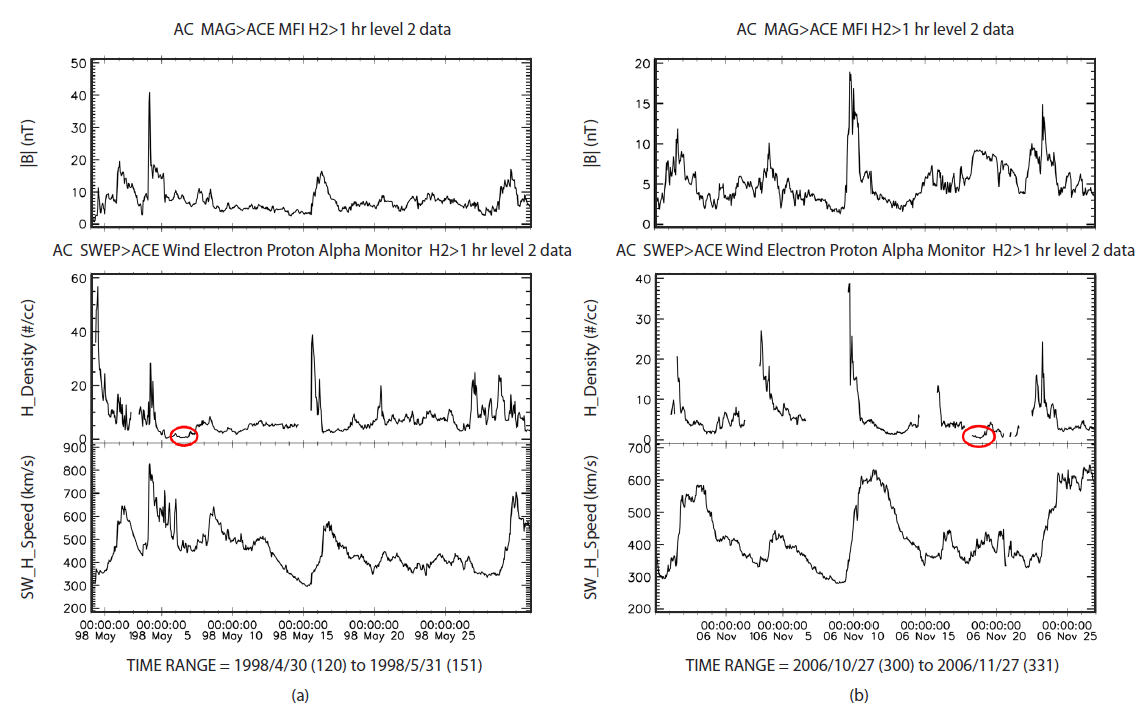
3. RESULTS
As a results of the analysis of ACE and Wind satellite data, we found solar wind density depletions from 1996 to 2013 corresponding to solar 23 cycle and solar 24 maximum and total events is 53. Table 1 is the events caused by shock wave before density depletion are 47 and the events by other source is 6 and we show the table as a bar graph (Fig. 3). We checked the paper of Richardson et al. (2001) that more than 80 % of the cause of occurrence of small and large geomagnetic storm at solar maximum and minimum was related to CME. We analyzed this phenomenon from solar 23 cycle to solar 24 maximum, not dividing into minimum and maximum. So the source of shock wave induced density depletion about CME occupy high percentage, about 60 % lower than Richardson’s research results and the source of shock wave shows 20 % by fast speed stream.
In order to find out the solar wind conditions which affect the duration and the scale of solar wind density depletions, analysis was made on the density, speed, and the intensity of magnetic field for solar winds accompanied by a shock wave. Also for the magnetic pressure that is proportional to the square of the magnetic field and the dynamic pressure that is proportional to product of the density and the square of speed, an analysis was made to find a correlation according to the reduction in the solar wind density. The duration of shock wave was defined as the period from the time when parameters rapidly increase to the time when the density depletion occur.
Although we believed that the correlation coefficient would be high because phenomena occurring in Sun-Earth system are constantly affected by solar activities, but the correlation coefficients between the density depletion and the magnetic fields and magnetic pressures of a shock wave are very low. Also, there is no relationship between the density depletion and other solar wind parameters such as speed, magnetic field and dynamic pressure.
Likewise in Section 3.2, we have analyzed the duration and the scale of all density depletion events for solar wind density, speed, the intensity of magnetic field, magnetic pressure and dynamic pressure, regardless of the presence of a shock wave. There is no correlation for solar wind speed. However, there is a little anti-correlation between the scale and the magnetic field and magnetic pressure during density depletion; the value is about 0.3. Average proton density during depletion is correlated with dynamic pressure and the coefficient is about 0.5.
To the end of introduction, we hypothesize that density depletion occur when the particles are pushed by shock wave or solar wind dynamic pressure in interplanetary space. There is no correlation between proton density during depletion and solar wind speed. Magnetic pressure is correlated with density, but the value is low (Fig. 4(b)). Also, solar wind dynamic pressure that is calculated with the square of density and speed is correlated with density during depletion (Fig. 4(a)). Therefore, we can know out hypothesis that the dynamic pressure during depletion would be pushed the solar wind proton density is right.
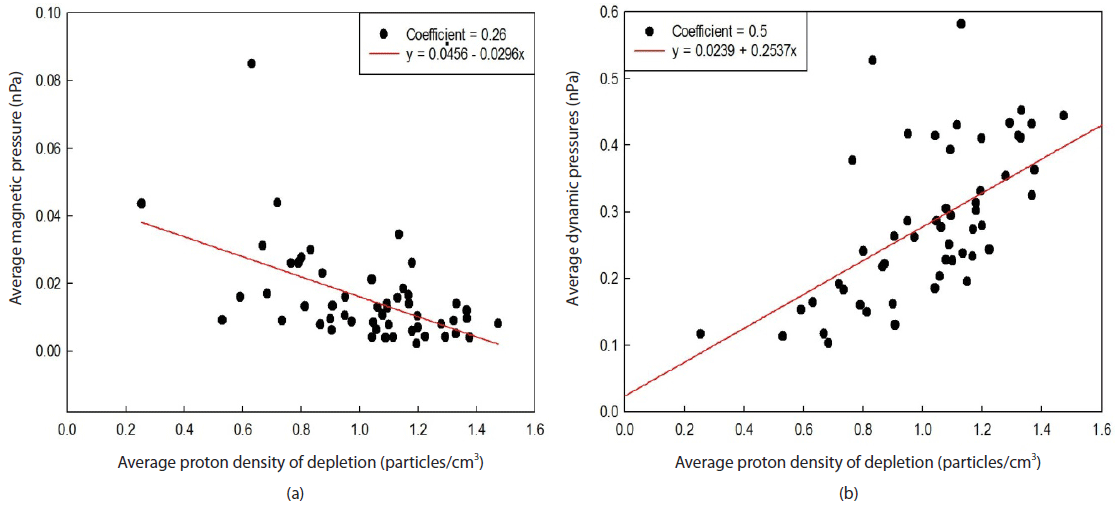
For 47 shock waves inducing density depletions, we have examined if there are the features of blast waves which are not shown in solar winds. It is not expected that the scale of shock waves are similar to that of blast waves because the energy and particles emitted from planetary nebula and supernova are much larger than those from the Sun. However, we have defined and classified shock waves showing the characteristics of blast waves according to the strength of magnetic fields, the solar wind speed, and the density using the ACE satellite data; more than 20 nT of the intensity of magnetic field, more than 600 km/s of the solar wind speed and more than 20 particles/cm3 of solar wind density. Based on this classification, 6 events were found to meet the above criteria, out of 47 events and we show the example of events in Fig. 5.
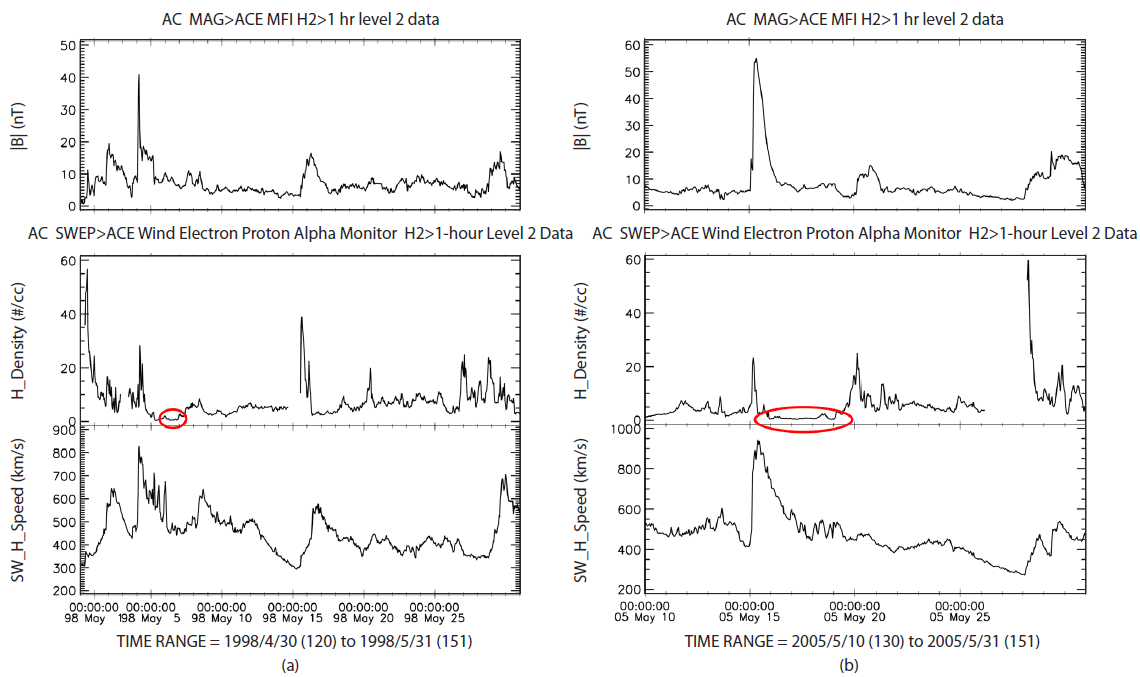
4. SUMMARY AND CONCLUSION
In the past, we could find a lot of researches on dropout and loss phenomena in which the flux of electrons decreases in the Earth radiation belts (Turner et al. 2014) or on the existence of depletion layer by the interaction of energetic particles with the magnetic field near the bow shock or near the magnetopause based on satellite observation. (Maynard et al. 2004) However, it was hard to find researches on the density depletion in the interplanetary space. Before or after Ohki’s research, the researches on the phenomenon of decrease in flux or proton density in the interplanetary space could not be found. Thus, the proton density depletions occurred by solar activities at locations farther than the Earth’s magnetosphere have been investigated based on satellite data and the effort was made to find the cause of density depletion occurrence.
As a result, we have found 53 events of density depletion during solar 23, 24 cycles and the number of phenomena by shock waves and other sources is 47 and 6, respectively. Richardson et al. (2001) reported that most of the shock waves generating large and small storms are related to CMEs, but in this research, it was found that shock waves by CMEs were about 60 %. Also, it was found that shock waves are produced by streams.
We have analyzed the correlation between solar wind dens-ity depletion and shock wave parameters, such as, density, speed, magnetic pressure, dynamic pressure and the intensity of magnetic field. And it was found that there is no correlation between the duration of density depletion and the shock wave parameters. For the scale of density depletion, the correlation coefficient with magnetic field is very low. It is speculated that shock waves push particles and the number of particles is reduced at the swept spot, but the shock wave does not have an effect on the density depletion.
As a result of correlation analysis within density depletions, it was found that there is no correlation with the duration similar to a result of correlation analysis on shock wave par-ameters, but the scale of density depletion is found to be anti-correlated with magnetic field and magnetic pressure and coefficient is 0.2. However, it is a well-correlated with dynamic pressure and coefficient is about 0.5 and we found out that dynamic pressure is important parameter to generate the density depletion.
We have analyzed the shock wave generated by solar winds. We’ve never heard and found any previous researches which reported that blast waves appeared in solar winds. The time to take to return to the original value is much longer in shock waves, but shock waves showed the similar features of blast waves. We have observed the degree of sudden decreases in the order of density, magnetic field and speed. In this research, since the analysis was made for the shock wave s priot to density depletions, we have found only 6 events during solar 23 and 24 cycles in this research (Fig. 5). If we investigate all shock waves in every year, we can find more shock waves characterized by blast waves.
We think that the cause of density depletion is a variation of IMF or dynamic pressure by solar activities, rather than shock waves associated with the solar winds. It is difficult to find the correlation between shock wave parameters and density depletions based on data analysis. However, there is anti-correlation between the scale of density depletion and the magnetic field and magnetic pressure and there is a correlation with dynamic pressure. According to many studies, components of IMF or speed had an effect on the phenomenon generating in Sun-Earth system. Thus, we need to study on the variation of IMF components, solar wind speed and the correlation between the scale of density depletions and IMF components and dynamic pressure related with speed.










